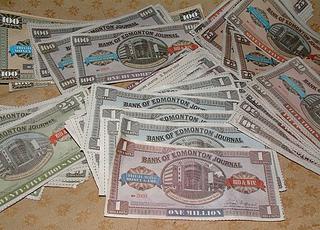
It seemed like fun contest -- at first...
In late September of 2005, the Edmonton Journal invited its readers to join in the "Money Game" which involved collecting 'money' printed in the paper for use in bidding for 24 prizes.
Available were cars, holiday trips and merchandise ranging from a $1,200 computer to a $30,000 Mini Cooper car and a $50,000 BMW. Bank notes for $25,000, $50,000, $75,000, $100,000 and $1 million appeared in the paper over about 10 days with a total of $2.5 million available to each subscriber.
No limits were set on how much more could be collected by various means.
Bidding opened on groups of four prizes per day for six days. While you could bid any amount on any prize, no one could win more than one. Bidding was to remain open for each group for three days, after which the names of the highest bidders were to be published.
I strategized how and when to bid, figuring the odds would be best for the lowest value prizes. But, obviously, I'd have to scrounge money from wherever -- from friends and relatives, by looking in papers left in coffee shops etc.
When the first of two $1 million notes were printed, things began getting crazy.
I decided to buy some papers, reasoning that buying 10 papers for their $1 million coupons
was no more foolish than buying some Lotto 649 tickets.
Trouble was, all the stores seemed to be sold out! And when I began to look for papers in the Journal street boxes, they were empty!
Someone wrote in The Journal's "Venting" section that they saw people methodically stealing armloads from Journal street boxes.
A United Way of Edmonton official said some of their agencies had members and supporters collecting Journal money in hope of winning a prizes for the agency.
With this kind of stuff going on, I figured I had to step up the ante or drop out.
I had no shame. I got more friends to collect for me. I did the rounds of several coffee shops, looking for discarded Journals. I climbed into newspaper recycling bins at several locations.
When the second $ 1 million note was printed, I was up before dark, looking for Journals at dozens of gas bars and convenience stores. They were all sold out except for one with a sign saying "limit of 2". I bought two.
My local Safeway store opened its doors at 8 a.m. and I was the first one in. There must have been 60 Journals for sale. I figured that in good conscience, I couldn't take more than 20. As I
left the check-out, I looked back and saw that a young couple had scooped all the rest...
By now I had amassed about $103 million, clipped from more than 240 papers. But I knew that I didn't have a hope in hell against thieves. Their bids would probably be in the BILLIONS of dollars.
When the names of the first four top bidders were published, I was dismayed to see that bid amounts were not shown. That would have set some kind of bench mark.
Still, I figured my wad might be worth something to other bidders and I tried to sell it in a Journal want ad. They refused to accept it. Nor would its competitor, the Edmonton Sun.
A few days later, a Journal ad said they had changed the rules.
Names of the top bidders would no longer be published because "unsportsmanlike" people hassled the top bidders. None of those named had been declared winners, it added.
Names and photos of all 24 winners will be published on or after October 23, it said.
It will be VERY interesting if The Journal is fair to its readers and publishes the bid amounts. Just as interesting would be to hear the winners explain how they amassed their dollars...
Addendum: After a two-week extension of the date for announcing the winners (because of the schmozzle created by the stupid rules), the names and pictures of the winners, together with their bid amounts, were published. They ranged from $301 million for the least desireable prize to $1,206 billion for the BMW and $4,851 billion for the Mini Cooper.
Considering how many papers I had to find to amass my bid, I figure the winner of the Mini Cooper had to collect at least 12,000 papers.
How was that possible? It would have made for a fascinating newspaper story. Curiously, not a word about it appeared in The Journal...
No comments:
Post a Comment